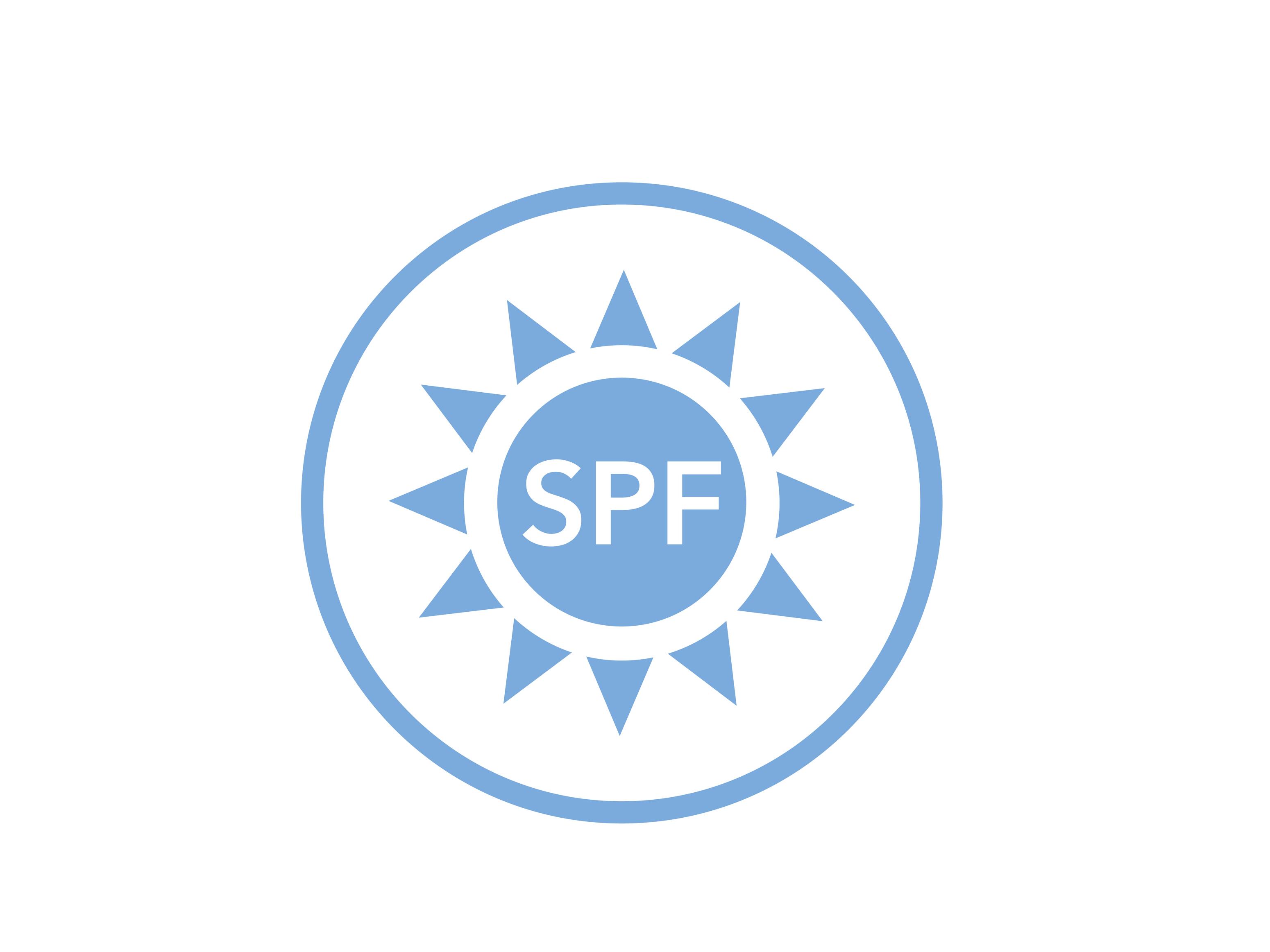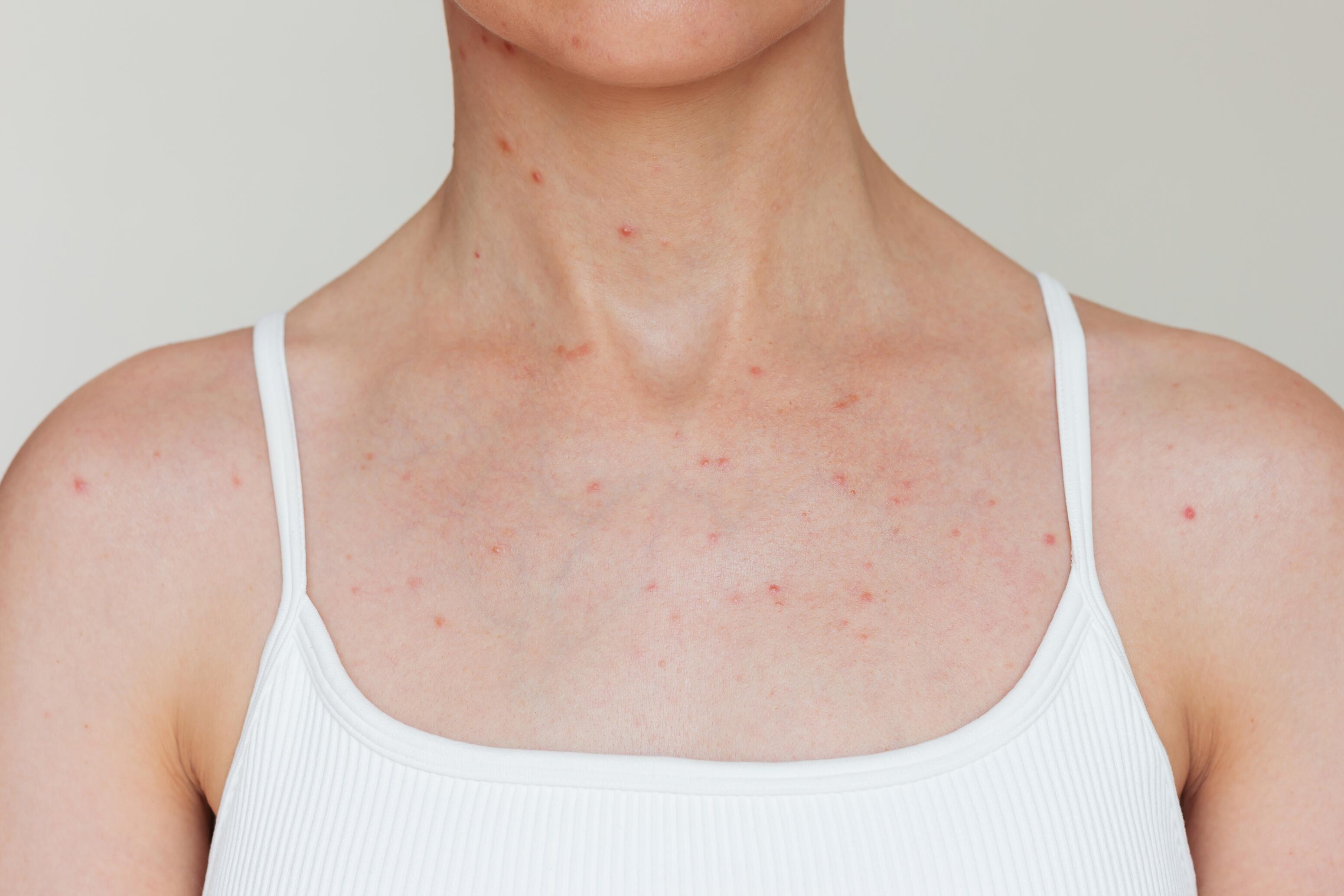Hormonal acne: causes, symptoms and treatments

Summary
What is hormonal acne?¹ ²
Hormonal acne refers to acne influenced by hormones, mainly androgens, which play a central role in its appearance. Acne is inherently hormonal since hormones regulate key mechanisms, such as the overproduction of sebum, which encourages the proliferation of Cutibacterium acnes. However, there are several categories of hormonal acne:
- Acne is linked to physiological hormonal fluctuations, which occur naturally at different stages of life, such as puberty, pregnancy, and menopause. These normal phases cause variations in the levels of androgens secreted by multiple organs, such as the adrenal glands, ovaries, testicles, and skin.
- Hormonal acne results from endocrine disorders (polycystic ovary syndrome, adrenal abnormalities or hormone-secreting tumours), often associated with other symptoms such as hirsutism (excessive hair growth in women, with thick, dark hair in areas that are usually male) or menstrual irregularities,
- Acne linked to medication that induces hormonal abnormalities.
Generally speaking, 'physiological' hormonal acne is more common in women due to hormonal fluctuations linked to the menstrual cycle, pregnancy and menopause, and less common in men in the absence of cyclical fluctuations. However, male acne tends to be more severe during adolescence due to significantly higher levels of circulating androgens.

What causes hormonal acne?
Hormonal acne is closely linked to the influence of hormones on the sebaceous glands and the skin.
Main hormones involved¹ ²
Androgenic hormones, such as testosterone and dihydrotestosterone (DHT), are produced mainly by the adrenal glands and sexual organs (ovaries, testicles) and influence the skin. In addition to endocrine organ production, they are synthesised by cutaneous enzymes from cholesterol.
Androgens promote the development of sebaceous glands and sebum production, which are key mechanisms in acne.
In teenagers, the increase in androgens during puberty is a major cause of acne.
Other hormones also influence acne:
- Insulin and IGF-1 stimulate sebum production and reinforce the effect of androgens on the skin.
- Cortisol, the stress hormone, promotes inflammation and can worsen acne.
- Oestrogens help to limit sebum production, but an imbalance can also contribute to the appearance of lesions.
Factors influencing hormones
Hormonal levels can be influenced by various external and internal factors which modulate the severity of acne, including:
- Natural hormonal fluctuations¹ ²: Life stages such as puberty, pregnancy, menopause, and the menstrual cycle involve normal hormonal changes that can trigger or worsen acne.
- Diet¹ ²: A diet rich in foods with a high glycaemic index or dairy products can stimulate the production of insulin and IGF-1, thereby amplifying acne.
- Stress¹ ²: It promotes the production of cortisol, increasing skin inflammation and sebum secretion.
- Endocrine disorders¹ ²: Conditions such as polycystic ovary syndrome (PCOS) or adrenal or ovarian gland tumourslead to overproduction of androgens and severe acne.
- Medication: Treatments, such as steroids, corticoids and anticonvulsants, alter the hormonal balance and favour acne onset.
Acne and endocrine pathologies: understanding the causes and symptoms¹
Hormonal acne can sometimes be a sign of a more profound hormonal imbalance linked to endocrine pathologies. These conditions, which alter the natural regulation of hormones, often lead to an overproduction of androgens or other hormonal imbalances that favour the appearance of severe acne. In addition to skin lesions, hormonal acne is accompanied by specific symptoms that may guide the diagnosis and provide a better understanding of its origin.
Polycystic ovary syndrome (PCOS)
This disease causes acne outbreaks that are often inflammatory and persistent. They are linked to an excessive secretion of androgens (such as testosterone) that interferes with normal follicular growth and triggers the symptoms. In addition to acne, PCOS can manifest with irregular or absent menstrual cycles, excessive hair growth in unusual areas (hirsutism), progressive male pattern hair loss affecting the upper forehead and crown, and difficulty conceiving. Many women also notice weight gain, mainly on the abdomen.
Diagnosis is based on blood tests and a pelvic ultrasound to detect polycystic ovaries.
Congenital adrenal hyperplasia
Congenital adrenal hyperplasia is a genetic disorder that leads to excessive production of androgens in childhood or adolescence. Sufferers may experience severe acne accompanied by signs of virilisation, such as a deeper voice or increased hair growth. The condition also disrupts normal development, with accelerated growth followed by early stop.
Diagnosis is based on specific blood tests, particularly for 17-hydroxyprogesterone, a key marker for the disease.
Other endocrine diseases
Other rare endocrine pathologies can cause or aggravate acne:
- Cushing's syndrome: Caused by an excess of cortisol, it leads to acne on the trunk and shoulders, weight gain on the face and neck, purplish stretch marks and muscle weakness.
- Androgen-secreting tumours: These cause a sudden and severe acne outbreak, often associated with signs of virilisation such as muscle mass gain or hair loss.
- Acromegaly: This condition is caused by an excess of growth hormone, which leads to persistent acne, oily skin, and enlarged facial features, hands, and feet.
Their diagnosis is based on hormone assays and imaging tests to identify the underlying cause.
Causes of medication-induced hormonal acne
Certain medicines can cause or worsen acne due to their interaction with hormones or specific side effects:
- Corticosteroids are known to trigger "steroid acne", causing inflammatory lesions on the trunk and shoulders.
- Progestins, used in contraceptive pills and implants, can exacerbate acne by interacting with androgen receptors.
- Some anti-epileptic drugs increase testosterone levels.
It should be noted that other drugs, such as lithium, promote acne via non-hormonal mechanisms by acting on the immune system and inflammation.
Acne and pregnancy: causes and symptoms³
During pregnancy, numerous hormonal and physiological changes affect the skin.

Causes of acne during pregnancy
The exact causes of pregnancy-related acne are not yet fully understood, but they are believed to be primarily driven by the significant hormonal shifts that occur during this time:
- Androgens, such as testosterone, increase significantly, particularly in the third trimester. These hormones stimulate the sebaceous glands, leading to excessive sebum production.
- Progesterone boosts sebum production and contributes to the proliferation of hair follicle cells.
- The hormones of the mother, baby and placenta interact and accentuate these effects.
- Oestrogens could help limit the effect of the hormones responsible for acne, but their role during pregnancy is still poorly understood.
Typical symptoms
Acne during pregnancy mainly appears on the face, with inflammatory lesions localised on the cheeks, forehead, around the mouth and under the chin. It can also extend to the trunk, particularly in the third trimester, when hormone levels peak.
While this type of acne is usually mild to moderate, some women may experience more severe breakouts—especially those with a history of acne or signs of hyperandrogenism, such as increased hair growth. Being overweight during pregnancy may also increase the likelihood of more intense flare-ups.
Hormonal treatments for acne² ⁴
General principles of acne treatment
Acne management is based on local treatments—such as retinoids and benzoyl peroxide—or systemic therapies like oral antibiotics or isotretinoin, depending on the severity of the lesions and the patient's profile.
Addressing the root cause of hormonal acne linked to an underlying endocrine disorder is essential, often requiring coordinated care with an endocrinologist.
In cases of medication-induced acne, identifying and, if possible, stopping the triggering drug is a key step, alongside tailored dermatological treatment to control the symptoms.
Contraceptive pills
Certain combined contraceptive pills, which contain both a progestogen and an oestrogen, can help treat acne in women by reducing the effect of androgens on the sebaceous glands. However, they are only prescribed to women who need contraception and for whom this method is appropriate.
The choice of contraceptive should always be discussed with a gynaecologist and a dermatologist to ensure it suits both medical needs and personal preferences.
Treatment of acne in pregnant and breast-feeding women³ ⁴
Several treatment options—such as topical and oral retinoids, oral antibiotics, and hormonal therapies—are not recommended during pregnancy and breastfeeding, as they may pose risks to the developing foetus or nursing infant. Therefore, the choice of acne treatments during this period is limited, and safety must be prioritised.
General acne prevention measures² ⁵
Adopting a consistent skincare routine and healthy daily habits can play a key role in reducing the risk of breakouts and supporting overall skin health.
Choice of non-comedogenic products and gentle gestures
Gentle cleansing and appropriate products are essential to maintain the skin's balance without aggravating the lesions:
- Use gentle cleansers designed for acne-prone skin. Avoid harsh products containing alcohol or irritating antiseptics.
- Choose non-comedogenic formulas that eliminate excess sebum without clogging pores.
- Avoid aggressive scrubs and practices that weaken the skin or exacerbate inflammation. Instead, use gentle methods to preserve the integrity of the epidermis.
Use soft products
Avoid scrubs
Lifestyle and diet
Adopting good daily habits can considerably reduce the risk of acne flare-ups:
- Do not manipulate pimples. Squeezing or scratching worsens the inflammation, prolongs its duration and increases the risk of scarring.
- Stress, by increasing sebum production, can worsen acne. Practices such as yoga, meditation or breathing exercises can help reduce its impact.
- A balanced diet can help prevent acne. Favour fruit, vegetables, wholegrain cereals and foods rich in omega-3s, which reduce inflammation. Limit products with a high glycaemic index (sweets, soft drinks) and, if necessary, moderate your consumption of dairy products.
- Smoking increases inflammation and impairs skin quality. Quitting benefits your skin and your overall health.
Appropriate sun protection
Although excessive sun exposure may temporarily improve the appearance of acne, it can worsen the condition over time.
To protect your skin, use a high-factor sunscreen specifically formulated for acne-prone skin. Avoid prolonged exposure, seek out shaded areas, and wear protective clothing to help maintain healthy skin.
Balance diet
Don't touch your face
Stress
No smoking
Sun protection
Sources
1. Lolis MS, Bowe WP, Shalita AR. Acne and systemic disease. Med Clin North Am. 2009 Nov;93(6):1161-81.
2. Sutaria AH and al. Acne Vulgaris. Treasure Island (FL): StatPearls Publishing; 2024 Jan. [Internet]. https://www.ncbi.nlm.nih.gov/books/NBK459173
3. Kutlu Ö and al. Acne in pregnancy: A prospective multicenter, cross-sectional study of 295 patients in Turkey. Int J Dermatol. 2020 Sep;59(9):1098-1105
4. Haute autorité de santé. Acné : quand et comment la traiter? HAS.fr. 2015 Nov. [Internet]. https://www.has-sante.fr/jcms/c_2574402/fr/acne-quand-et-comment-la-traiter
5. L'assurance maladie. Acné. Que faire et quand consulter. Ameli.fr. 2024 Jun. [Internet]. https://www.ameli.fr/assure/sante/themes/acne/bons-reflexes-bons-gestes
- Discover Retention Acne: A Guide to Effective Care and Solutions
Retention Acne: A Guide to Effective Care and Solutions
- Discover Acne and Rosacea: Symptoms and Effective Treatments
Acne and Rosacea: Symptoms and Effective Treatments
- Discover Severe Acne: Types, Causes, and Suitable Treatments
Severe Acne: Types, Causes, and Suitable Treatments
- Discover Acne on the body: back, chest, torso - causes and solutions
Acne on the body: back, chest, torso - causes and solutions












